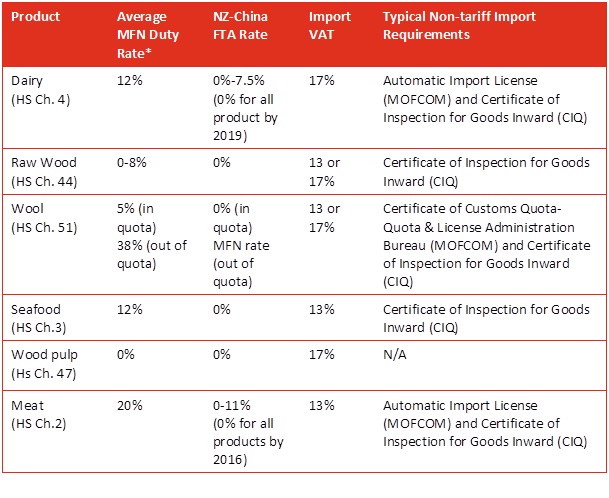
Trade Advice
By Damon Paling, Partner - PwC China
Overview
The NZ-China FTA has aided in reducing measures that create transaction costs for New Zealand made goods the Chinese border. International studies have shown that an FTA can reduce the landed cost of products on average by between 3% and 7%. Such cost savings may go some way to also offset the negative effect of a high New Zealand Dollar. However, several tariff barriers still remain and various other non-tariff measures and levies continue to be applied to New Zealand goods entering mainland China.
This article provides further insight on the barriers that still exist at the Chinese border for NZ exporters and what actions can be considered in order to reduce the cost impact that these measures have on your export competitiveness and profitability.
The regulatory landscape
China, in conjunction with acceding to the World Trade Organisation (WTO) over ten years ago, and as an active member in the World Customs Organisation (WCO), has implemented fairly standard customs and trade law. For example, similar to New Zealand, China adopts the Harmonised System (HS) for determining the tariff classification of goods, which is used to define both tariff and non-tariff barriers. China also follows the WTO Valuation agreement and assesses duties based on the Cost, Insurance and Freight (CIF) value. Import Value Added Tax (VAT) is assessed – typically at the rate of 17% – and this should be creditable against local output VAT, and therefore not a cost of goods sold (cash flow item only).
On-the-ground operations
Notwithstanding the above regulatory measures, the following practical realities still face importers of NZ made goods at the Chinese border:
- New or amended customs and trade rules and regulations are issued from time to time by different authorities and sometimes with limited forewarning
- China Customs has over 40 regional Customs Houses and 600 local Ports of Entry with enforcement of laws and regulations decentralised, which means that local Customs and Commodity Inspection Quarantine (CIQ) offices may have a different interpretation of the same rule.
- Customs duty is one of the main revenue sources for central government and with China Customs collecting around 22% of that total, revenue gathering is their primary goal.
- For good reasons, non-tariff measures are still applied by the Chinese authorities to a wide range of NZ products entering China in order to ensure consumer protection, uphold national security, and the like
The following table highlights ‘at the border barriers’ for NZ’s leading exports to China:

Helping your Customers in China
In principle, slight discrepancies between the wording and detail stated on the Certificate of Origin or Declaration of Origin that the importer in China submits to China Customs, if of no material effect, should not cause their claim for preferential tariff treatment to be denied. However, in practice, it is not always that simple, so ensuring consistency in all documentation is essential in order to reap the benefits.
As the NZ exporter, getting the basics right is still fundamental, which means ensuring consistency across all documentation, including the commercial invoice, import and purchase contract, packing list, Bill of lading/airway bill and Certificate of Origin / Declaration of Origin and Export/Hygiene Certificate. This will then enable your Customer in China to more readily complete the Import Declaration Form, obtain other product specific import licenses, inspection certificates, and complete the duty payment and goods clearance release process.
Lead times
When shipping via airfreight, approximately 50% of importers can clear goods through Customs within 2 – 5 days whilst when shipping via ocean freight, approximately 75% of importers can clear goods through Customs within 3 – 7 days. Against this backdrop and given the multiple Ports of Entry that exist, consulting with your Customer about where best to deliver the goods is an important conversation, as is selection of local service providers in China, namely Import/Export Agents and Customs Brokers. Their compliance record, enterprise ranking and relationships with the authorities are still vital to success at the border. Market rates for customs declaration fees and the like can be benchmarked and ‘at cost charges’ for inspections and testing by the authorities can be supported with official receipts.
Conclusions
Roll-out of the tariff reductions negotiated under the NZ-China FTA is taking place. However, several non-tariff measures and on-the-ground complexity still exists when your Customer imports New Zealand made goods into mainland China. Hurdling of these barriers can be aided by ensuring consistency in all export/import documentation, selection of appropriate INCOTERMS and nomination of a preferred place of delivery, and partnering with the right Customs Brokers and related service providers on both the New Zealand export and China import sides. China Customs are themselves are also implementing various positive trade facilitation measures – such as paperless customs clearance – which in the future will aid in reducing the time for New Zealand made goods to reach the Chinese consumer.
Damon Paling is a Customs & International Trade Partner with PricewaterhouseCoopers and is based in Shanghai, China. He can be reached at damon.ross.paling@cn.pwc.com. Damon has 14 years experience in Asia advising companies on customs, trade and related supply-chain and logistics matters, the last 8 years of which have been spent in China. Damon co-authored the ‘Quick Reference Guide to the Trade and Customs Law of China’ and has a Masters in Customs Law and Administration from the University of Canberra in Australia.
To share your industry knowledge and expertise on trade with China please contact Luke Qin at luke.qin@nzcta.co.nz
Nov 13, 2012











